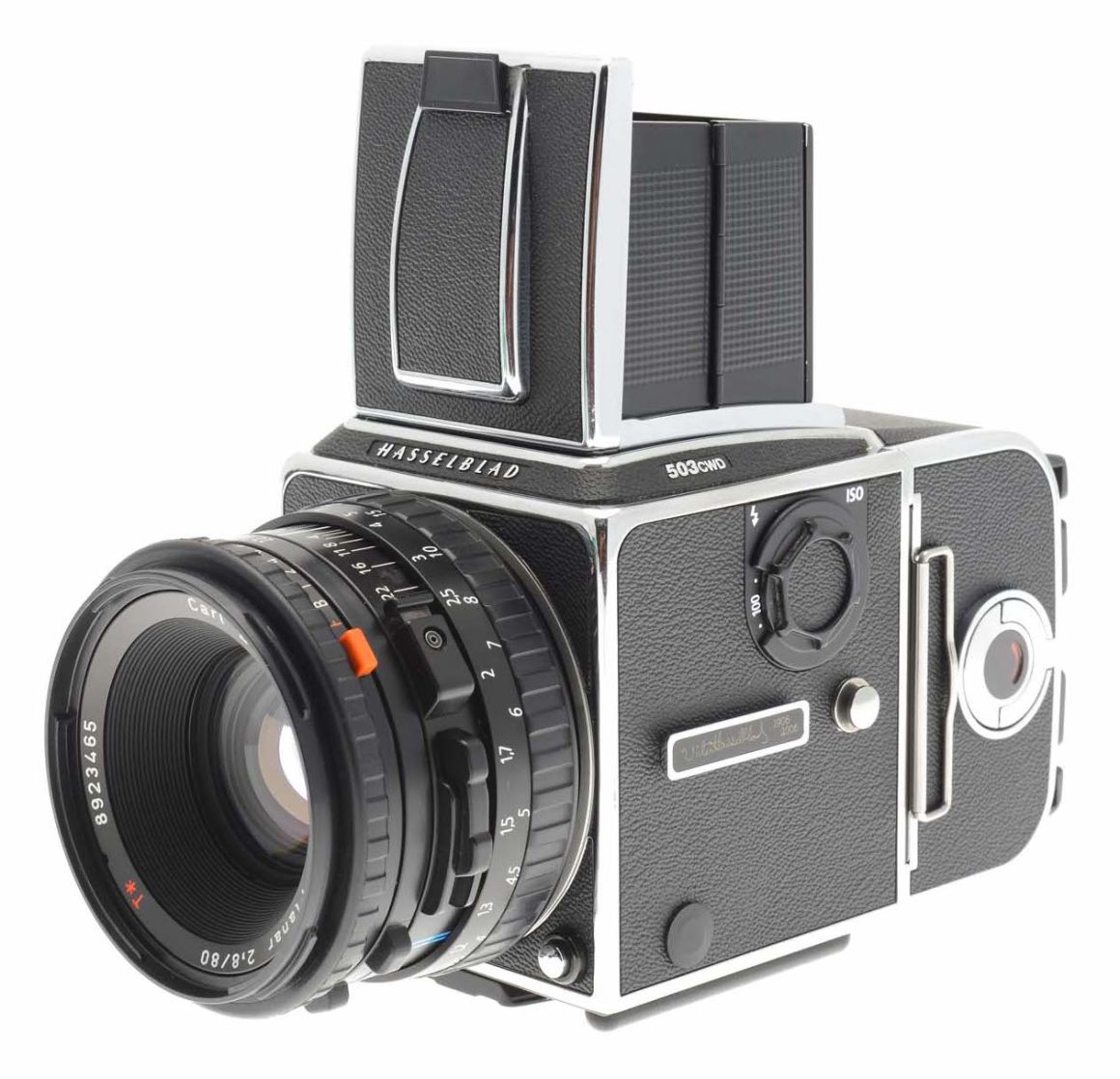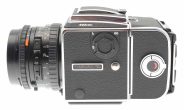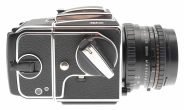Hasselblad 503CWD "Victor Hasselblad 100th Anniversary"
Medium format MF film SLR camera • Collectible
Specification
| Production details: | |
| Announced: | March 2006 |
| Production type: | Small-batch production: 500 (five hundred) units |
| System: | ● Hasselblad V (1957) |
| Format: | |
| Maximum format: | Medium format 6x6 |
| Film type: | 120 roll film |
| 220 roll film | |
| Mount and Flange focal distance: | Hasselblad V [74.9mm] |
| Shutter: | |
| Type: | In-lens leaf shutter |
| Exposure: | |
| Exposure metering: | None |
| Exposure modes: | Manual |
| Physical characteristics: | |
| Weight: | 1620g |
| Dimensions: | 193x113x110mm |
Manufacturer description #1
28/02/2006 - Hasselblad Celebrates Centenary of Founder’s Birth with Launch of Limited Edition Hasselblad 503CWD Digital Camera
In recognition of the centenary of Victor Hasselblad’s birth on 8th March 2006, Hasselblad today unveiled the Hasselblad 503CWD Anniversary Kit, a prestige high-end photographic system that offers state-of-the-art digital capture technology elegantly integrated with a classically designed Hasselblad 503CW body.
Combining the rugged reliability of the black and chrome V System body, with its range of high performance, central shutter-based lenses, and Hasselblad’s latest digital technology, the exclusive Hasselblad 503CWD perfectly melds the heritage of the old Hasselblad with the focus of the new Hasselblad on digital high-end photography to create a new digital workhorse. Of undoubted appeal to the Hasselblad connoisseur, the camera delivers the perfect blend of versatility and simplicity in a compact, professional tool that gives the user complete control over digital image capture and is a pleasure to operate.
Christian Poulsen, CEO of Hasselblad, comments: “Hasselblad’s reputation for excellence and outstanding quality was built on the V System. Therefore the Hasselblad 503CWD – a truly professional tool that is fully compatible with the Hasselblad V system, offers great value for money, and is built to the same exacting standards that have become the signature of the Hasselblad company - is a fitting tribute to the design process that Victor Hasselblad started himself in the 1940s. Having been passionate about photography, Victor would also have loved the concept of digital photography, and in the 503CWD kit, with its stylish retro body and advanced digital capture technology offering the ideal balance of old and new Hasselblad, he would recognize the culmination of his own work.”
The 503CWD Anniversary kit will be supplied as a limited edition of 500 cameras, each one numbered and engraved with Victor Hasselblad’s signature. Reassuringly solid, the kit comprises the 503CWD integrated digital camera with waist-level viewfinder, specially marked focusing screen and chrome winding lever, a Zeiss Planar CFE 2.8/80mm lens, and a beautifully produced book marking Victor’s anniversary.
Not only does the Hasselblad 503CWD satisfy the aesthetic needs of V System fans, but it also boasts very advanced and, in some aspects, unique digital technology, such as Hasselblad Natural Color Solution, Instant Approval Architecture, and versatile storage and workflow, alongside files captured on a CCD 50% larger than a full frame 35mm DSLR.
Hasselblad Natural Color SolutionColor management solutions have in the past imposed limitations on professional digital photographers, because of the forced choice of a specific color profile to suit the job: for example, capturing various skin tones, metals, fabrics or flowers. To combat this, Hasselblad has developed the Hasselblad Natural Color Solution to be used with its FlexColor imaging software. Working with the powerful, new Hasselblad Natural Color Solution enables professional photographers to produce outstanding, reliable out-of-the-box colors, with skin tones, special product gradations, and other difficult colors accurately reproduced.
Instant Approval Architecture
Some of the potential benefits of capturing large numbers of images can be lost if the photographer cannot quickly review and select the best images to present to the client. Hasselblad’s Instant Approval Architecture (IAA) assists by labelling images according to technical parameters and allowing the photographer to downgrade visually poor images, having previewed them on the clear, bright OLED viewing screen. Sorting the red, amber or green flagged images is then very quick. Audible and visible signals facilitate the selection process by giving instant feedback during a shoot.
Three modes of operation and storage
Optimum portability and image storage are critical for the professional photographer. Hasselblad 503CWD offers a choice of the portable CF card storage, the flexible Imagebank, or the tethered operation with extended, special capture controls. With these three operating and storage options, the photographer is able to select a mode to suit the nature of the work at hand, whether in the studio or on location.
For the studio photographer, the most accurate colours and highest degree of control can be achieved by using 3F RAW (3FR), Hasselblad’s raw file format, in Hasselblad’s workflow software, FlexColor. The file format also includes lossless image compression, saving 33% of storage space. In tethered operation tools such as live video and overlay masking bring increased productivity to advanced set composition. The newest FlexColor version allows the photographer to manipulate color temperature and compare image details across multiple images for precise image selection. Alternatively the 3FR files can be converted directly into Adobe’s raw image format DNG (Digital NeGative), which can be opened directly in Adobe PhotoShop CS2.
New digital back, the CFV, also available
Hasselblad is also launching the CFV, a new digital back and the successor of the V96C back, for existing Hasselblad V System users.
Built to match the design and functionality of the Hasselblad V System cameras, it can be easily and elegantly integrated into an existing Hasselblad system, enabling the photographer to work in exactly the same manner and with their preferred equipment, but with the productivity benefits of digital photography over film.
The Hasselblad 503CWD will be available from Hasselblad’s Digital Partners in March at a list price of 11,900 Euros, excluding VAT and the Hasselblad CFV will similarly be available at a list price of 8,990 Euros, excluding VAT.
Manufacturer description #2
Camera type: Single lens reflex camera with 6 x 6 cm (2 1⁄4 x 2 1⁄4 in) max. film size. Interchangeable lenses, film magazines, viewfinders, and focusing screens.
Design: Mechanical, with an aluminum alloy camera body shell cast in one piece.
Viewfinder: Folding focusing hood interchangeable with reflex viewfinder, prism viewfinders with or without built-in light meter, or magnifying hood.
Film advance: Manual advance or motor driven with Winder CW. Simultaneous shutter winding. Winder CW winding time: 1.05 s, approx. 0.8 frames/sec in continuous mode.
Flash control: TTL/OTF-metering. ISO 64−4000 with flash adaptors SCA390 for connection with flash units from the SCA 300 systems. Metering area within 40 mm diameter in the centre of the image area.
Tripod coupling: 1⁄4 in. and 3/8 in. socket threads and base plate for quick coupling attachment.
Focusing screen: Hasselblad Acute-Matte D focusing screen with sensor format markings.
Sensor size: 16 million pixels.
Sensor dimensions: 36.7 x 36.7 mm.
Lens factor with V camera: 1.5.
Shooting mode: single shot.
Multi shot upgrade: not available.
File format: Lossless compressed Hasselblad 3F RAW format (3FR) or 3F.
Capture rate: 35 frames per minute.
Image storage: CF card type II; 100 GB portable Imagebank; computer disk with tethered shooting mode.
Colour definition: 16 bit.
Dynamic range: 12 f-stop.
Color management: Hasselblad RGB; full dynamics; reproduction dynamics.
Color display: OLED type, 2.2 inch, 24 bit color.
IR filter: Mounted on CCD sensor.
ISO speed range: 50, 100, 200, 400.
Battery power: SONY InfoLithium L, up to 8 hours of shooting capacity.
Host connection: Firewire 800 (IEEE1394b).
Operating temperature: 0 – 45 deg. C / 32 – 113 deg F.
***
The year 2006 marks the centenary of Victor Hasselblad, the founder of the world famous Hasselblad camera. It is therefore fitting that in commemoration of this anniversary, a camera should be be dedicated to his memory and with links to the both the past and the future. The Hasselblad 503CWD is just that.
The Hasselblad 503 CW is an extremely popular model from the 500 series. Soon after it was launched it became the workhorse for so many photographers, professional and amateur alike. It is an all-rounder, being as easy to use on location as in the studio. Entry into the new millenium naturally offered the opportunity of digital capture. Even though the camera design is mechanical, the modular concept allows the integration of a digital back to secure the optimal combination.
There are many who prefer a more traditional design of camera while wishing to exploit the latest in technology and that is where the Hasselblad 503 CWD comes in. It offers the best from both worlds, mechanical and electronic.
Hasselblad is the choice of the world’s leading photographers, and the name is synonymous with compatability, reliability and image quality, reaching beyond the ends of the earth and into space.
The System
The Hasselblad 500 system is the most comprehensive medium-format photographic system in the world. It offers magazines for different image formats and films, viewfinders with or without exposure metering capabilities, a number of focusing screens to mention just a few items to suit your special requirements.
The Camera
The 503CWD features the sophisticated GMS (Gliding Mirror System) which provides a full viewfinder image with virtually all Hasselblad ‘C’ lenses. The bright viewfinder image is further enhanced by the improved focusing screen from the brilliant 'Acute-Matte D' range. The completely mechanical camera body boasts a one-piece aluminium alloy construction for serious work. The Winder CW, specifically designed for the 503CW models, provides fast sequential photography and various choices of remote control, including IR. Altogether, a winning combination for professional or dedicated amateur use.
The Lenses
You have access to the whole range of Hasselblad ‘C’ series lenses both old and new. Lenses are specially manufactured for Hasselblad by Carl Zeiss of Germany − the indisputable leader in camera optics. The Hasselblad specifications of these lenses exceeds the demands made by digital capture to ensure the optimum in performance whatever the chosen medium. The Hasselblad V system features more than a dozen different lenses, as well as 1.4x and 2x teleconverters. The integral shutter feature combines with the TTL/OTF facility to provide tremendous flash freedom.
The Digital Back
The 16 Mpix based digital back is custom built to fit the design and functionality of Hasselblad V cameras with its range of high performance, leaf-shutter based lenses. However, it can also fit onto view cameras using the V-system interface plate for mechanical attachment and flash sync connection to trigger the digital capture for optimum compatibility and economy. It provides both cable free and computer tethered options to suit all types of work. The back offers an ultra high level of integration, image quality and flexibility to the specialist professional photographer or highend amateur user.
Instant Approval Architecture: Limitless digital image capture loses some of its potential if the photographer cannot quickly review and select the best image. Building on the success of its Audio Exposure Feedback technology, Hasselblad has created Instant Approval Architecture (IAA), an enhanced set of feedback tools, designed to liberate the photographer to focus on the shoot rather than the selection process. IAA triggers audible and visible signals for each image captured, telling the photographer immediately whether the image has a red, yellow or green light status. The information is recorded both in the file and in the file name, providing a quick and easy way to classify and select images, in the field or in the lab. A larger, enhanced OLED display provides a realistic, high quality and perfect contrast image view, even in bright sunlight, to allow instant on-site image approval. IAA is a Hasselblad trademark and is patent pending.
Large format digital capture: Today’s photographers demand higher resolution, less noise, and improved flexibility, all of which the 503CWD addresses. The 503CWD uses an optical format allowing for digital capture with sensors more than twice the physical size of today’s 35mm sensors. The sensor can therefore hold more and larger pixels, which secure a high-end image quality in terms of moiré free color rendering without gradation break-ups in even the finest lit surfaces.
“Instant” user interface: The 503CWD is operated with a straight forward user interface with a series of “instant” one-button-click operations including: instant capture, instant browse, instant approval, instant zoom, and instant image info.
Three modes of operation and storage: Optimum portability and image storage are critical for the professional photographer. 503CWD offers a choice of portable CF card storage, flexible FireWire drive, or tethered operation with extended, special capture controls. With these three operating and storage options, the photographer is able to select a mode to suit the nature of the work at hand, whether in the studio or on location.
Hasselblad 3F RAW files: Hasselblad 3F image raw files carry full sets of metadata, including capture conditions, keywords and copyright, facilitating work with image asset management solutions. The files also define the colours in the Hasselblad RGB colour space, removing the need for experimenting with different colour profiles to get optimal colours and the need for selective colour corrections.
From the editor
A special limited edition Hasselblad 503CW camera released in 500 units in 2006 to commemorate the 100th anniversary of the birth of Victor Hasselbad. Each camera was numbered and engraved with Victor Hasselblad’s signature. Each camera was supplied in a kit consisting of the 503CWD integrated digital camera with waist-level viewfinder, specially marked focusing screen and chrome winding lever, a Carl Zeiss Planar 80mm F/2.8 CFE lens, and a book marking Victor’s anniversary.
Dimensions are indicated for the complete camera with the 80mm Planar CFE lens. The weight is indicated excluding battery and CF card.
Table of contents
Clickable
Instruction manual
Clickable
Hasselblad V system cameras
Clickable
- Hasselblad 2000FC
- Hasselblad 2000FC/M
- Hasselblad 2000FCW
- Hasselblad 2003FCW
- Hasselblad 201F
- Hasselblad 202FA
- Hasselblad 203FE
- Hasselblad 205FCC
- Hasselblad 205TCC
- Hasselblad 500 Classic
- Hasselblad 500C
- Hasselblad 500C/M
- Hasselblad 500EL
- Hasselblad 500EL/M
- Hasselblad 500ELX
- Hasselblad 501C
- Hasselblad 501CM
- Hasselblad 503CW
- Hasselblad 503CX
- Hasselblad 503CXi
- Hasselblad 553ELX
- Hasselblad 555ELD
- Hasselblad 903SWC with Carl Zeiss Biogon T* 38mm F/4.5 CF
- Hasselblad 905SWC with Carl Zeiss Biogon T* 38mm F/4.5 CFi
- Hasselblad FlexBody
- Hasselblad SWC with Carl Zeiss Biogon [T*] 38mm F/4.5 C
- Hasselblad SWC/M with Carl Zeiss Biogon T* 38mm F/4.5 C
- Hasselblad SWC/M with Carl Zeiss Biogon T* 38mm F/4.5 CF


